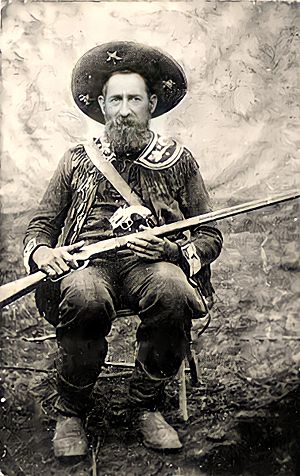Devil Anse Hatfield facts for kids
William Anderson Hatfield (born September 9, 1839 – died January 6, 1921) was a very important person in the famous Hatfield–McCoy feud. People often called him Devil Anse. He was the leader of the Hatfield family during this long-standing conflict. The feud has become a well-known part of American folklore. Anse lived through the feud and agreed to help end it in 1891.
Contents
Who Was Devil Anse Hatfield?
William Anderson Hatfield was born on September 9, 1839. This was in an area that is now Logan, West Virginia. His parents were Ephraim and Nancy (Vance) Hatfield.
His nickname, "Devil Anse," has a few possible stories behind it. Some say his mother gave him the name. Others believe it came from Randolph McCoy, the leader of the rival McCoy family. Another idea is that he earned it because he was very brave during battles in the American Civil War. It might also have been used to show how different he was from his calm cousin, Anderson "Preacher Anse" Hatfield.
Hatfield's Role in the Civil War
Hatfield supported the Southern states during the American Civil War. In 1862, he joined the Confederate Army. He became a First Lieutenant of Cavalry in the Virginia State Line. This group worked to protect the border area between Kentucky and Virginia. People in this region had mixed feelings about supporting the North or the South.
The Virginia State Line later broke up in 1863. Hatfield then joined the 45th Battalion Virginia Infantry as a private. He was later promoted to first lieutenant and then captain. His unit mostly patrolled the border. They fought against people who supported the Union.
Devil Anse and his uncle, Jim Vance, also formed a small fighting group. It was called the "Logan Wildcats." This group was part of the Confederate forces.
Life After the War
Devil Anse left the Confederate Army in 1864. He went back home to his family in West Virginia. There, he started buying land. Even though he couldn't read or write, he built a very successful lumber business. He gained control of many acres of untouched forest land. He won this land in a legal case against Perry Cline, who was related to the McCoy family.
The Hatfield–McCoy Feud
Devil Anse was the main leader of the Hatfield family during the famous Hatfield-McCoy feud. His family and Randolph McCoy's family had one of the most well-known and violent feuds in American history. He was a key figure in many of the conflicts. Many of his sons and friends were arrested during this time.
Later Life and Faith
On September 23, 1911, Hatfield was baptized. This happened in Island Creek. He became a Christian, changing his earlier views on religion. After his conversion, he helped start a Church of Christ group in West Virginia. He was also the uncle of Henry D. Hatfield. Henry later became the Governor of West Virginia and a United States Senator.
Family Life
Hatfield married Levisa "Levicy" Chafin on April 18, 1861. She was the daughter of Nathaniel Chafin and Matilda Varney. They were married in Logan County, West Virginia. They had 13 children together.
Hatfield Children
| Name | Nickname | Lifespan | Son/Daughter | Notes |
|---|---|---|---|---|
| Johnson Hatfield | Johnse | 1862–1922 | Son | Known for his relationship with Roseanna McCoy. He later married her cousin, Nancy McCoy. |
| William Anderson Hatfield, Jr. | Cap | 1864–1930 | Son | He was a deputy sheriff in Logan County, West Virginia. |
| Robert Lee Hatfield | Bob | 1868–1931 | Son | He ran a saloon in Wharncliffe, Mingo County, in the 1890s. |
| Nancy Bell Hatfield Vance-Mullins | Nannie | 1869–1939 | Daughter | |
| Elliott Rutherford Hatfield | 1872–1932 | Son | He was a doctor in Kanawha County, West Virginia. | |
| Mary Hatfield Hensley Simpkins Howes | 1873–1963 | Daughter | Her husband, Frank Howes, was a fiddler from Catlettsburg, Kentucky. | |
| Elizabeth Hatfield Caldwell | Betty | 1876–1962 | Daughter | |
| Elias M. Hatfield | 1878–1911 | Son | ||
| Detroit W. Hatfield | Troy | 1881–1911 | Son | |
| Joseph Davis Hatfield | Joe | 1883–1963 | Son | He was a Republican sheriff of Logan County, West Virginia. |
| Rosada Lee Hatfield Browning | Rosie | 1885–1965 | Daughter | |
| Emmanuel Willis Wilson Hatfield | Willis | 1888–1978 | Son | |
| Tennyson Samuel Hatfield | Tennis | 1890–1953 | Son | He was a Republican sheriff of Logan County, West Virginia. |
Death and Legacy
Hatfield passed away on January 6, 1921. He was 81 years old. He died from pneumonia at his home in Sarah Ann, West Virginia. He is buried in the Hatfield Family Cemetery. This cemetery is located along West Virginia Route 44 in southern Logan County. His grave has a life-sized statue of him made from Italian marble. His wife, Levicy, lived for eight more years after he passed away.
Devil Anse in Pop Culture
Actor Kevin Costner played Devil Anse Hatfield in a TV show. It was a miniseries called Hatfields & McCoys in 2012. Kevin Costner won awards for his acting in this role.
Devil Anse also appears as a ghost in a collection of short stories. This book is called Who Fears the Devil? It was written by Manly Wade Wellman in 1963.
Images for kids
See also
 In Spanish: Devil Anse Hatfield para niños
In Spanish: Devil Anse Hatfield para niños



